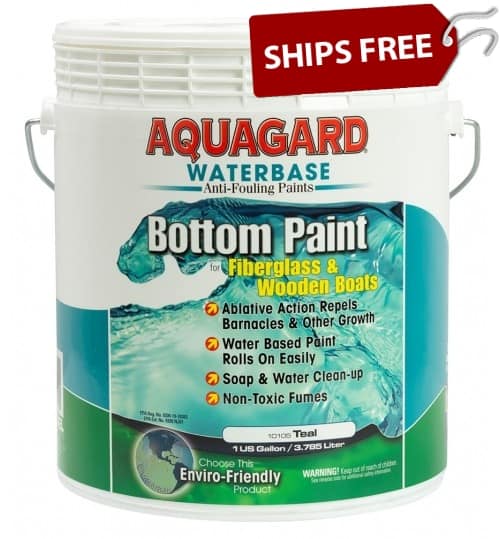Antifouling paint can be applied to many different substrates including wooden boats. What is the recommended procedure for preparing the surface? Is a primer needed? What paint should I use? This article should answer all those questions. The Bottom Paint Store has 3 water-based antifouling products: Aquagard, Sea Hawk Monterey, and Interlux Fiberglass Bottomkote Aqua.
Aquagard Water-based Antifouling Bottom Paint
When applying antifouling paint to wooden boats, primer is optional. Antifouling paint can seep into the wood grain and create a strong bond. Usually, the first coat is thinned 10% to assist in penetrating the wood grain. Then the subsequent coats can be applied normally.
If adhesion is a major concern, then primer will promote adhesion. There are 2 Aquagard primers to choose from: 181 Solvent based primer and 190 Water based primer. They both accomplish the same task, but the water-based version has less VOC’s (volatile organic compounds). If you choose to use a solvent based primer and then a water based paint, make sure the primer is completely cured before proceeding. You can read the full application instructions on the Aquagard product page.
Monterey Self Polishing Solvent Free Bottom Paint
When applying Sea Hawk Monterey to a wood hull, no primer is needed. You can use the same method of thinning the product to allow it to seep into the wood grain. If the wood can accept more paint after the first coat, you can repeat the process a second time. Here is the step by step process for Monterey:
Step 1 – CLEAN SURFACE
Surface must be clean, dry and free of contaminants.
Step 2 – SAND & CLEAN
Sand to a uniformly frosty, dull looking surface with 80-100 grit (no finer) sandpaper; remove any residue.
Step 3 – APPLY ANTIFOULANT
Apply two coats of Sea Hawk antifouling by brush, roller or spray. Apply first coat thinned 10% and let dry overnight. Apply two more coats of bottom paint allowing 3 to 6 hours between coats and a minimum overnight dry.
Interlux Fiberglass Bottomkote Aqua
BARE WOOD: It is essential to remove all contaminants from the surface prior to sanding and overcoating.
Sand with 80 grit paper.
Clean with Special Thinner 216. Repair any defects with Watertite Epoxy Filler.
Lightly sand and wipe clean. Surface must be free from all contamination.
Fill seams, if necessary, with Seam Compound Brown 30.
Apply first coat of Fiberglass Bottomkote® Aqua thinned with clean water (do not add more than 10% by volume).

